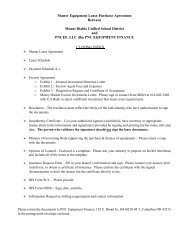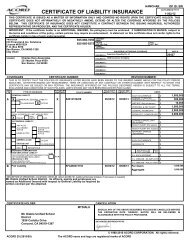Study of the Mount Diablo Unified School District - Mt. Diablo Unified ...
Study of the Mount Diablo Unified School District - Mt. Diablo Unified ...
Study of the Mount Diablo Unified School District - Mt. Diablo Unified ...
- No tags were found...
Create successful ePaper yourself
Turn your PDF publications into a flip-book with our unique Google optimized e-Paper software.
Introduction and Peer <strong>District</strong> Comparisons<strong>of</strong> programmatic evaluation tasks and activities with cost analysis tasks and activities,<strong>the</strong>reby yielding a more comprehensive analysis <strong>of</strong> <strong>the</strong> true efficiency, effectiveness, andcosts associated with special education services. MGT utilizes quantitative and qualitativedata analysis to evaluate <strong>the</strong> strengths <strong>of</strong> special education services and delivery models, toanalyze MDUSD services, and to identify areas in need <strong>of</strong> improvement. Our methodologyis based on our extensive experience conducting similar studies throughout <strong>the</strong> country.The MGT review team used various types <strong>of</strong> instruments for collecting data and informationnecessary to complete <strong>the</strong> special education study, including:• Peer <strong>District</strong> Comparison/Benchmarking. The practice <strong>of</strong> benchmarking is <strong>of</strong>tenused to make comparisons between and among school districts. Benchmarkingrefers to <strong>the</strong> use <strong>of</strong> commonly held organizational characteristics in making concretestatistical or descriptive comparisons <strong>of</strong> organizational systems and processes. It isalso a performance measurement tool used in conjunction with improvementinitiatives to measure comparative operating performance and identify bestpractices. With this in mind, MGT performed a benchmarking comparison <strong>of</strong>MDUSD to provide a common foundation from which to compare systems andprocesses within <strong>the</strong> school district with those <strong>of</strong> o<strong>the</strong>r, similar districts. MGT andMDUSD jointly selected <strong>the</strong> peer districts based on factors such as studentenrollment, student achievement, and student‐to‐staff ratios.• Stakeholder Survey Instruments. The instruments created to survey administrators,special education teachers, general education teachers, support staff, and parentswere developed from a comprehensive list <strong>of</strong> evaluation questions we havedeveloped through our experience with similar specialized studies. We jointlyselected items appropriate for specific surveys for each group <strong>of</strong> stakeholders. Thestakeholder surveys were tailored so that <strong>the</strong> opinions <strong>of</strong> multiple stakeholdergroups could be compared in <strong>the</strong> analysis <strong>of</strong> <strong>the</strong> results. The purpose <strong>of</strong> <strong>the</strong> surveyswas to provide information on indicators <strong>of</strong> program quality and cost effectiveness.Complete survey results are included in Appendix A. MGT uses a statistical formulato establish <strong>the</strong> survey response rate in order to declare <strong>the</strong> survey results are“representative” <strong>of</strong> <strong>the</strong> population surveyed. In instances when <strong>the</strong> target returnrate is not achieved, <strong>the</strong> results may still be used as indicators <strong>of</strong> stakeholderperceptions. In <strong>the</strong> case <strong>of</strong> MDUSD, response rates for general education teachersexceeded <strong>the</strong> standard; all o<strong>the</strong>r survey groups were below <strong>the</strong> standard, as shownin Exhibit 1‐1.MGT <strong>of</strong> America, Inc. Page 1‐2















